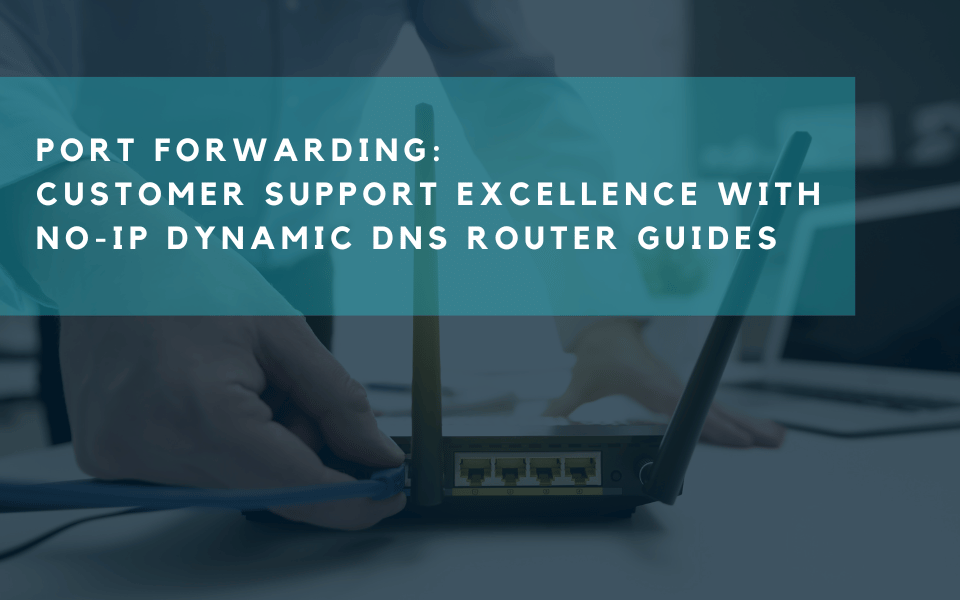
At No-IP, Customer Support is one of our top priorities. We are dedicated to helping our users make the most of our services and resolving any issues they may encounter. One common challenge faced by many users is setting up port forwarding on their routers to work with No-IP’s Dynamic DNS service. To make this process easier and ensure a seamless experience, we have compiled a list of port forwarding guides for some of the most popular routers.
Each guide provides step-by-step instructions for setting up port forwarding to enable remote access for devices like security cameras and gaming consoles. By following these guides, you’ll be able to configure your router to work smoothly with No-IP’s Dynamic DNS service, allowing you to enjoy the full benefits of our services.
Netgear Routers
Step 1: Log in to your router’s web interface by entering its IP address (usually 192.168.1.1 or 192.168.0.1) in your browser.
Step 2: Enter your router’s username and password.
Step 3: Click on the “Advanced” tab, then select “Port Forwarding/Port Triggering” under the “Advanced Setup” menu.
Step 4: Choose “Add Custom Service” and enter the necessary details for the device you want to set up.
Step 5: Click “Apply” to save your changes.
For a detailed guide, visit: Netgear Router Port Forwarding Guide
Linksys Routers
Step 1: Log in to your router’s web interface by entering its IP address (usually 192.168.1.1) in your browser.
Step 2: Enter your router’s username and password.
Step 3: Click on the “Security” tab, then select “Apps and Gaming” from the menu.
Step 4: Choose “Single Port Forwarding” or “Port Range Forwarding” depending on your needs, and enter the necessary details for the device you want to set up.
Step 5: Click “Save” or “Apply” to save your changes.
For a detailed guide, visit: Linksys Router Port Forwarding Guide
TP-Link Routers
Step 1: Log in to your router’s web interface by entering its IP address (usually 192.168.1.1 or 192.168.0.1) in your browser.
Step 2: Enter your router’s username and password.
Step 3: Click on the “Forwarding” tab, then select “Virtual Servers” from the menu.
Step 4: Click on “Add New” and enter the necessary details for the device you want to set up.
Step 5: Click “Save” to apply your changes.
For a detailed guide, visit: TP-Link Router Port Forwarding Guide
ASUS Routers
Step 1: Log in to your router’s web interface by entering its IP address (usually 192.168.1.1 or 192.168.0.1) in your browser.
Step 2: Enter your router’s username and password.
Step 3: Click on the “WAN” tab, then select “Virtual Server/Port Forwarding” from the menu.
Step 4: Click on “Add Profile” and enter the necessary details for the device you want to set up.
Step 5: Click “Apply” to save your changes.
For a detailed guide, visit: ASUS Router Port Forwarding Guide
D-Link Routers
Step 1: Log in to your router’s web interface by entering its IP address (usually 192.168.1.1 or 192.168.0.1) in your browser.
Step 2: Enter your router’s username and password.
Step 3: Click on the “Advanced” tab, then select “Port Forwarding” from the menu.
Step 4: Click on “Add Rule” and enter the necessary details for the device you want to set up.
Step 5: Click “Save” or “Apply” to save your changes.
For a detailed guide, visit: D-Link Router Port Forwarding Guide
Belkin Routers
Step 1: Log in to your router’s web interface by entering its IP address (usually 192.168.1.1 or 192.168.0.1) in your browser.
Step 2: Enter your router’s username and password.
Step 3: Click on the “Virtual Servers” tab, located under the “Firewall” section.
Step 4: Click on “Add” and enter the necessary details for the device you want to set up.
Step 5: Click “Apply Changes” to save your settings.
For a detailed guide, visit: Belkin Router Port Forwarding Guide
Cisco Routers
Step 1: Log in to your router’s web interface by entering its IP address (usually 192.168.1.1 or 192.168.0.1) in your browser.
Step 2: Enter your router’s username and password.
Step 3: Click on the “Applications & Gaming” tab, then select “Port Range Forwarding” from the menu.
Step 4: Enter the necessary details for the device you want to set up and click “Add to List.”
Step 5: Click “Save Settings” to apply your changes.
For a detailed guide, visit: Cisco Router Port Forwarding Guide
Ubiquiti Routers
Step 1: Log in to your router’s web interface by entering its IP address (usually 192.168.1.1) in your browser.
Step 2: Enter your router’s username and password.
Step 3: Click on the “Settings” tab, then select “Firewall/NAT” from the menu.
Step 4: Go to the “Port Forwarding” tab and click “Add New Port Forward Rule.”
Step 5: Enter the necessary details for the device you want to set up and click “Save.”
For a detailed guide, visit: Ubiquiti Router Port Forwarding Guide
If you’d like to learn more about port forwarding and how it works, we recommend reading our blog post: The Magic of Port Forwarding: How Does it Work?. This informative article will help you gain a better understanding of port forwarding, its benefits, and how it can enhance your remote access experience with No-IP’s Dynamic DNS service.
These port forwarding guides should help you configure popular routers to work with No-IP’s Dynamic DNS service. Always remember to consult your router’s user manual or manufacturer’s website for specific instructions on port forwarding, as the process may vary slightly between router models. If you need further assistance or encounter issues while setting up port forwarding, don’t hesitate to Open a Support Ticket with our Customer Support team.